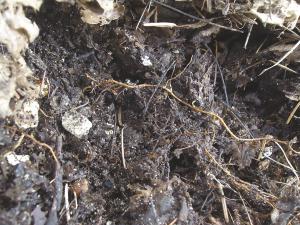Leaf mold a better soil amendment than compost
Fall is time for cider, a blazing fireplace and anagrams. Anagrams and leaf raking, that is. What to do with all of those leaves? Make leaf mold. Leaf mold is a type of compost that is really a soil amendment rather than a fertilizer. Leaves need fungus to break down over a long period of time. After a year or so the leaves become a dark brown, almost black spongy material with a pleasant forest smell.
Instead of going through the bother of making a compost pile and adding other ingredients, you can make leaf mold all by itself. Also, leaf mold is a much better soil amendment than compost. In fact, if you just leave a pile of leaves in a corner of the garden it will break down over a few years on its own. The process is faster if you first chop the leaves by running them over with a lawnmower.
You can also make leaf mold in a plastic garbage bag with leaves, moistening the leaves and poking some holes in the bag for air circulation. Fill the bag with leaves and moisten them. Seal the bag and then cut some holes or slits in the bag for air flow. Let it sit. Check the bag every month or two for moisture, and add water if the leaves are dry.
After six months to a year, you will have finished leaf mold. Impatient? There are a couple of things you can do to speed up the process:
Before adding leaves to your pile or bag, run over them a couple of times with your lawn mower. Smaller pieces will decompose more quickly.
Use a shovel or garden fork to turn your leaf pile every few weeks. If you are using the plastic bag method, just turn it over or give it a firm shake. This will introduce air into the process, which speeds decomposition.
If you are using the pile or bin method, cover your pile with a plastic tarp. This will keep the leaves more consistently moist and warm.
Because leaf mold doesn’t contain as much nitrogen as compost you will still want to add compost and organic fertilizer such as bone meal to your soil. To avoid any traces of chemicals in your leaf mold, avoid using pesticides or chemical fertilizers on your lawn right before raking the leaves. If some traces of chemicals are transferred from the grass to the leaves it will be minor.
Because it takes a relatively long time for leaves to break down into leaf mold, you don’t have to worry too much about chemical contamination, because the long time frame lets some chemicals to break down as well. That said, never use any leaves from gutters or streets because they often contain pollutants such as fuel and oil residue.
Use leaf mold as a substitute for peat moss because unlike peat moss, leaf mold is a renewable resource.
Because leaf mold can hold up to 500 times its own weight in water it makes an excellent mulch. Leaf mold also opens up the soil and acts as a natural soil conditioner.
Lighter soil makes it easier for roots to grow. Soil amended with leaf mold provides a good habitat for earthworms and beneficial bacteria.
You can mix leaf mold into your houseplant potting mixes to lighten and aerate them.
Instead of throwing out your leaves, pile them up, wet them down, and make leaf mold. Then get back to your cider and anagrams, like the anagram for “old flame”: “leaf mold.”


















































